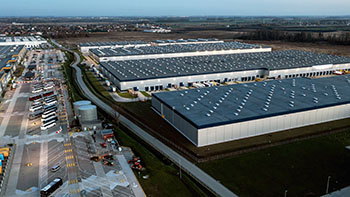In the ever-evolving landscape of logistics and warehousing, Prologis, the world's largest logistics landlord, continues to observe the remarkable resilience of industrial property demand. Despite a shifting economic focus away from goods, Prologis remains optimistic about the sector's future. This article delves into recent developments within the industrial-property market, highlighting key statistics and insights that shed light on the industry's current state.
largest logistics landlord, continues to observe the remarkable resilience of industrial property demand. Despite a shifting economic focus away from goods, Prologis remains optimistic about the sector's future. This article delves into recent developments within the industrial-property market, highlighting key statistics and insights that shed light on the industry's current state.
Prologis has recently raised its guidance for average occupancy, suggesting that the anticipated slowdown in warehouse demand may be reaching its nadir. This shift is occurring as businesses reconfigure their supply chains in response to broader economic uncertainties. Factors such as rising interest rates and international tensions are affecting the pace of expansion in the warehousing sector.
According to Prologis Chief Financial Officer Tim Arndt, central banks' "hawkish posture" and its impact on interest rates are influencing companies' decision-making processes regarding new logistics space. Additionally, the geopolitical backdrop has become more uncertain, further clouding the demand outlook.
Warehouse and Distribution Center Key Insights
1. Upwardly Adjusted Occupancy Guidance
Prologis now expects average occupancy for the year to range between 97.25% and 97.5%, a revision upward from the previous estimate of 97% to 97.5%. This adjustment signifies a degree of stability in the demand for industrial properties, despite the challenges posed by the evolving economic landscape.
2. Earnings Outlook Adjustment
Simultaneously, Prologis has revised its earnings outlook, narrowing the range to $3.30 to $3.35 per share, compared to the earlier guidance of $3.30 to $3.40 per share. This adjustment reflects the company's efforts to adapt to changing market dynamics.
3. Shifting Demand Trends
The shift from consumer spending on goods to services in the United States, along with falling global trade volumes, has contributed to weaker demand for warehouse space. After three years of robust growth during the Covid-19 pandemic, the industrial-property vacancy rate in the U.S. has risen from a historic low of 2.9% in the second quarter of 2022 to 4.1% in this year's second quarter. While leasing rates have slowed, they remain above pre-pandemic levels.
In conclusion, Prologis's observations underscore the adaptability and resilience of the industrial-property market. Despite the challenges posed by changing economic dynamics and global uncertainties, the demand for warehouse space remains steady.
Prologis's upwardly revised occupancy guidance and the adjustment of its earnings outlook demonstrate the company's commitment to navigating the evolving landscape of the logistics and warehousing industry. As we move forward, it is essential for businesses to stay agile and responsive to changing market conditions to thrive in this dynamic environment.
Working with a warehouse design consultant will help to understand how to maximize your current and future facilities needs.




SHARE